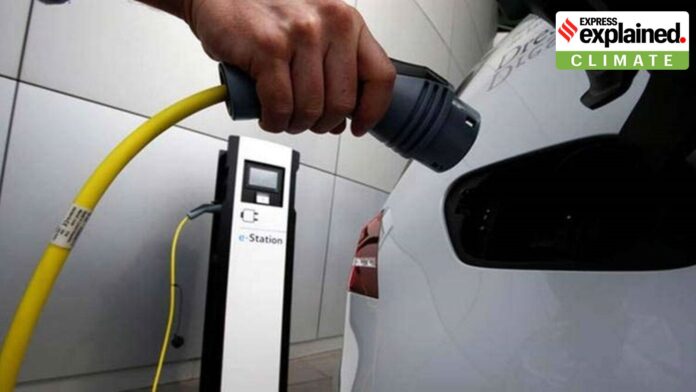By eliminating greenhouse gas (GHG) emissions, electric vehicles (EVs) play an important role in the fight against climate change. However, while contributing to solving one problem, they may be adding to another.
A new study by Indian researchers has found that EVs may be bad news for tackling air pollution.
The study, published in Soft Matter, a journal of the Royal Society of Chemistry, has shown that EVs, on account of their greater weight, experience higher wear and tear in their tyres compared to conventional vehicles, and release substantially larger numbers of small plastic particles in the atmosphere.
This could have adverse implications for the health of both humans and the environment.
How tyres are degraded
The disintegration of automobile tyres results in the release of small rubber particles that are air pollutants.
The normal wear and tear of tyres produces particles of broadly two sizes – one, about 1-10 micrometres; the other, more than 100 micrometres. Particles of intermediate sizes are also produced, but they are relatively fewer in number.
The study by researchers from the Tata Institute of Fundamental Research (TIFR), IIT Bombay, and Columbia University in the US has, for the first time, established the relationship between the weight and speed of a vehicle to the size of the plastic particles released from tyres as a result of wear and tear. (‘Mechanism of microplastic and nanoplastic emission from tire wear’, Shankar Ghosh et al.)
The tyres of heavier and faster-moving vehicles produce a higher proportion of smaller particles, shows the study. Unlike the larger particles that settle on the ground due to gravity, smaller particles remain suspended in the air, adding to the concentration of air pollutants.
The study also brings out, for the first time, that particles of different sizes are produced by different physical processes of degradation of tyres.
Thus, degradation caused by sudden braking or encounters with potholes, which the researchers call “primary fragmentation”, results in the release of mainly smaller particles of varying sizes.
And gradual wear and tear, called “sequential fragmentation” in the study, leads to the release of mainly larger particles.
Thus, an improvement in road quality would likely reduce the release of larger particles, but would have little effect on the smaller particles.
Global relevance of study
The results of the study are globally relevant because of the ongoing push for the adoption of EVs. Electric vehicles are significantly heavier than conventional petrol vehicles because of the batteries – which can weigh anything between 300 kg and 900 kg.
The weight of the batteries necessitates the reinforcement of the vehicle frame, which adds to the overall weight. Typically, an EV is at least 15-20% heavier than a comparable conventional vehicle.
EVs are also able to accelerate more rapidly. This can lead to additional stress on the tyres due to increased friction and heat generation.
The tyres of EVs are, therefore, likely to undergo a greater degree of primary fragmentation, releasing larger amounts of smaller plastic particles that add to the concentration of pollutants in the atmosphere.
The findings of the study shed new light on the relatively lesser-studied negative impacts of the deployment of EVs, which is being incentivised around the world.
Road transport accounts for almost 10% of global GHG emissions, the result primarily of the burning of fuel in vehicles.
EVs account for just about 2% of the global vehicle stock, but they contributed to about 20% of new car sales across the world last year, according to an International Energy Agency report.
In India, about 2.5% of cars sold in 2024 were electrics, according to a recent report by S&P Global. The government aims to take this figure to about 30% by 2030. In China, EVs accounted for almost half of all car sales last year.
Potential responses
The researchers say their findings call for different kinds of response measures.
Current air quality regulations in most countries are aimed at controlling PM2.5- and PM10-size particles. Tyre fragments are smaller than these.
With the proliferation of EVs, and tyre fragments becoming a more noticeable constituent of air pollution, these regulations would probably need to be expanded.
At the same time, tyre manufacturers would need to invest in research and development to produce sturdier tyres that are better suited to heavier EVs.
Also, emissions standards would probably need to account for non-exhaust emissions from vehicles.
The researchers have also suggested possible technological fixes – such as the possibility of capturing the small tyre fragments at the time of their release, preventing them from getting into the atmosphere.


